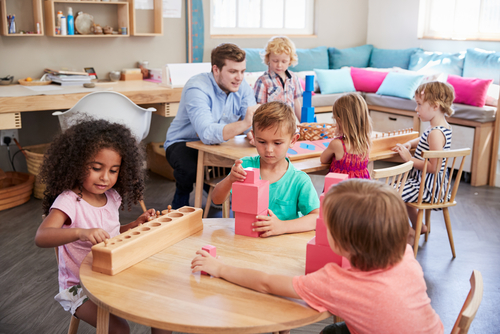Start them young, so they say, and for any parent wanting to give the best to their child, choosing the right school is a very important decision that must be made with careful research.
Daycare is the first thing that comes to mind when you think about early childhood education. It has been the choice of parents for many years and has proved beneficial for many children. Montessori schools, however, are gaining more recognition around the world with their unique teaching methods focused on giving a child more freedom with their learning. So, which should you consider for your child?
Teacher Versus Child: Who Should Take the Lead?
A typical daycare center follows the traditional teaching approach: the child sits at a desk and the teacher does most of the teaching, writing on the board and providing activities that the child needs to complete at a given time. In this environment, the teacher leads the learning process and the child just follows the instructions provided.
The Montessori way, on the other hand, focuses on the concept of following the child. In a Montessori classroom, the child is given the freedom to choose the activities that they are most interested in while the teacher guides them in achieving the established goal. Collaboration between the child and the teacher is important and learning is spread throughout the classroom.
1:6 Versus 1:12: What Is the Ideal Class Size?
In recent years, a lot of daycares switched to a 1:12 ratio in classes to cut down costs. With more students under their care, teachers may not have enough time to focus on the needs of each child and it could take a toll on quality of learning. A Montessori school, however, typically maintains a 1:6 ratio. By limiting the number of students for each classroom, a teacher will have more time to guide each child throughout the learning process and offer more interaction with students.
Calm Versus Chaos: Which Is the Ideal Environment?
While it’s typical for a place filled with children to be chaotic at times, a calm and orderly environment is needed to promote learning. A Montessori classroom is very orderly with materials organized in shelves that are easily accessible to children. Objects are carefully chosen and kept to a minimum to give children the opportunity to maximize play without getting confused. A daycare, however, can get quite messy and because of the number of students in each classroom, the environment may be more chaotic than that of a Montessori classroom.
When it comes to reporting a child’s progress, traditional daycares give report cards to parents while Montessori schools provide portfolios, narrative reports and checklists. The teacher in daycares also determine the pace of learning while Montessori educators let their students determine their own pace.
Mastering curriculum objectives is the main goal of traditional daycares while Montessori schools focus on letting a child fall in love with learning. At the end of the day, the decision whether to send a child to daycare or Montessori depends on what will work best for the child and their parents.
Kid’s Town Montessori School is centrally located at 867 Sycamore Avenue in Vista, California and is proud to serve the cities of: Vista, San Marcos, Escondido, Carlsbad, San Elijo Hills and many more

